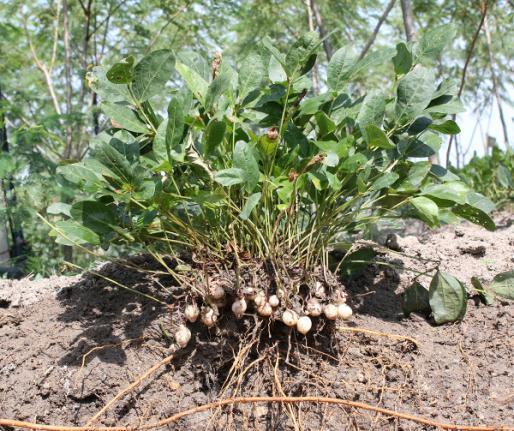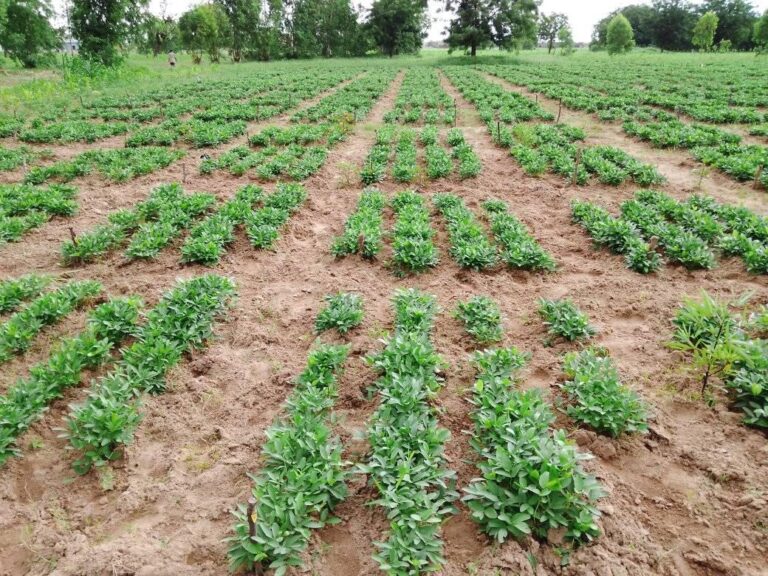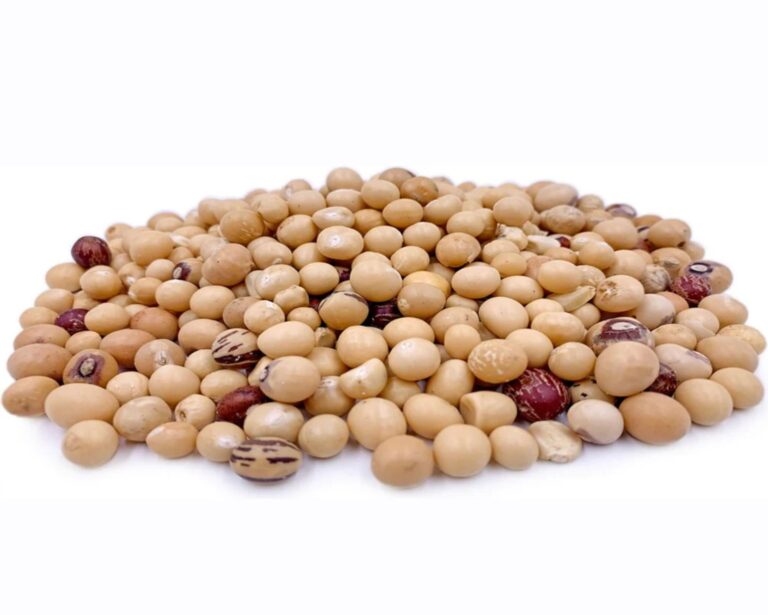Assessment of bambara groundnut landraces for resistance to Cowpea aphid borne mosaic virus
Key words: Bambara groundnut, cowpea aphid-borne mosaic virus (CABMV), bean common mosaic virus strain-blackeye cowpea mosaic (BCMV-BlCM), double antibody sandwich enzyme-linked immunosorbent assay (DAS-ELISA), reverse transcription-polymerase chain reaction (RT-PCR). Auteurs : N’Golo Moussa KONATE, Adjima OUOBA, Hervé NANDKANGRE, Essowè PALANGA, Théodore OUEDRAOGO, Mahama OUEDRAOGO and Mahamadou SAWADOGO Source : http://www.ifgdg.org
Molecular characterization of the main fungi associated to Bambara groundnut foliar diseases in Burkina Faso.
Objective: This study aims to update the database of fungi associated to Bambara groundnut foliardiseases in Burkina Faso using both molecular and morphological identification approaches.Methodology and Results: In this study, molecular approach based on the sequencing of ITS (InternalTranscripted Spacer) region of fungi and morphological approach were used to identify the main fungiassociated to Bambara…
Phenotyping of Bambara Groundnut Landraces for Resistance to Macrophomina phaseolina (Tassi) Goidnich.
Bambara groundnut [Vigna subterranea (L.) Verdcourt] is one of the most important subsistance legumes cultivated inBurkina Faso, due to the high nutrient content of its seeds. However, bambara groundnut production can be seriouslyconstrained by fungal diseases that reduce yields. Macrophomina phaseolina is one of fungal pathogen that causes importantdamage in bambara groundnut fields in Burkina…
Variabilité de la coloration du tégument des graines de voandzou cultivées au Burkina Faso et les noms locaux associés
Vigna subterranea (L.) Verdcourt specie is a traditional African legume, grown in all parts of Burkina Faso. It plays a huge role in the resilience of poor people to food and nutritional insecurity. In order to contribute to the safeguarding of the genetic resources of this specie and to better valorize it in the selection…
Molecular characterization of virus isolates from genus Potyvirus infecting Vigna subterranea in Burkina Faso
Bambara groundnut (Vigna subterranea) is an African legume with a great nutritional, economic and social potential. However, one of the main constraints to this crop is viral diseases which reduced yields. Indeed, approximately 12 viruses have been reported to infect bambara groundnut. Among these, only four were reported from Burkina Faso, namely, cowpea aphid-borne mosaic…
Assessment of genetic diversity in Bambara groundnut (Vigna subterranea (L.) Verdcourt) landraces in Burkina Faso using microsatellite markers (SSR)
Bambara groundnut is an important source of protein to the rural majority in sub-Saharan Africa. However, smallfarmers grow locally adapted landraces which are generally low yielding. Adequate knowledge of variability within Bambara groundnut germplasm collections is crucial for crop improvement and has importantimplications for conservation, management and future usefulness of germplasm resources. The objective of…
Genetic diversity analysis of Burkina Faso Ginger (Zingiber officinale Rosc.) landraces using microsatellite markers
Identification and characterization of germplasm is important for efficient management strategies in conservation and utilization of plant genetic resources. This investigation aimed to assess genetic diversity of 47 ginger landraces from Burkina Faso base on polymorphism of eight SSR primers. Seven of theses primers produced 60 loci out of which 95.3% were found to be…
Aperçu de la culture du voandzou (Vigna subterranea (L.) Verdcourt) au Burkina Faso: enjeux et perspectives d’amélioration de sa productivité
Le voandzou constitue avec le niébé, les deux principales légumineuses alimentaires pour de nombreuses populations rurales et la frange pauvre des citadins au Burkina Faso. Cependant, des informations émanant de l’environnement de production de cette culture selon la perception des producteurs sont quasi inexistantes. Cette étude vise à s’informer au mieux des réalités sociales, environnementales et techniques qui entourent…
Variability, Correlations, Heritability and Genetic Advance of Rhizome Yield and Yield Related Traits in Ginger (Zingiberofficinale Rosc.) Landraces from Burkina Faso
Ginger (Zingiberofficina leRosc.) is an economically important plant, valued all over the world. Ginger was introduced in Burkina Faso several decades ago, and is commonly called « Gnamankou ». Identification and characterization of germplasm is an important link between the conservation and utilization of plant genetic resources. A total of 56 ginger ecotypes collected from…
Morphometric and agronomic characterization of 56 ginger landraces in Burkina Faso
This study aims to characterize and assess the variability within the ginger accessions growing in Burkina Faso for morphometric and agronomic traits in order to identify appropriate strategies for the future breeding program. The experiment was conducted with 56 accessions in Randomized Complete Block Design with four replications. Moderate diversity was observed for morphometric and…
Caractérisation du système de production du gingembre (Zingiber officinale Rosc.) au Burkina Faso : potentialités, contraintes et perspectives
Le gingembre est une herbacée annuelle. C’est l’une des plus importantes épices à travers le monde et est d’une importance économique avec de nombreuses vertus médicinales. Cette étude vise à caractériser le système de production du gingembre (Zingiber officinale Rosc.) au Burkina Faso dans le but de mieux faire connaître l’espèce et de mettre en…
Délices culinaires à base de Voandzou: explorer de nouvelles saveurs
Le Voandzou, un ingrédient aux multiples facettes Le Voandzou, loin d’être un simple aliment de base, se révèle être un ingrédient culinaire versatile et savoureux. Sa texture tendre et son goût légèrement sucré permettent de l’intégrer à une multitude de recettes, des plats traditionnels aux innovations Un voyage culinaire à travers le monde En Afrique…
Cultiver le Voandzou: un atout pour l’agriculture durable
Le Voandzou, une plante au service de l’environnement Le Voandzou est une légumineuse tropicale qui s’adapte parfaitement aux climats secs et aux sols pauvres. Sa rusticité et ses nombreux atouts en font un allié précieux pour une agriculture durable et respectueuse de l’environnement. Un atout pour la fertilité des sols Le Voandzou a la capacité…
Le Voandzou, un super-aliment oublié
Le Voandzou, une légumineuse méconnue Originaire d’Afrique de l’Ouest, le Voandzou, aussi appelé pois bambara, pois de terre ou « gounga », est une légumineuse oubliée qui mérite d’être redécouverte. Cette plante robuste et résistante aux conditions difficiles s’avère être un véritable trésor nutritionnel et un atout précieux pour l’agriculture durable. Un concentré de nutriments Le Voandzou…



